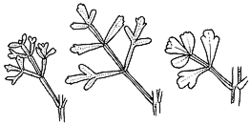Common name: Coast Boronia
Boronia anemonifolia subsp. variabilis (Hook.) P.G.Neish APNI* Synonyms: Boronia anemonifolia var. varabilis (Hook.) Benth. APNI*
Boronia dentigeroides Cheel APNI*

Description: Erect shrub 0.2–2 m high; branchlets glabrous or pilose in 2 lines separated by ± glabrous decurrent leaf bases, glandular-warty.
Leaves ± glabrous, bipinnate or pinnate with 3–5 leaflets; inflorescences mostly 6–9-flowered. Leaves 3–5-foliolate or bipinnate, prominently glandular, glabrous or glabrescent, 13–35 mm long; petiole mostly 5–9, rarely to 16 mm long; leaflets simple, flattened, broad-cuneate to oblanceolate, apex entire or 3-toothed, 3–13 mm long, 1–4 mm wide, terminal leaflets usually shorter.
Inflorescences axillary, mostly 3–6-flowered (range 1 to more than 9 flowers); pedicels 1.5–6 mm long. Calyx glabrous to hirsute. Petals 4–6 mm long, imbricate, white to pale pink, glabrous, not persistent in fruit.
Cocci glabrous.
Distribution and occurrence: Widespread, chiefly on the ranges. NC CC SC NT CT ST; Qld, Vic, Tas. Grows in heath, woodland and dry sclerophyll forest, usually among rocks.
NSW subdivisions: NC, CC, SC, NT, CT, ST
Other Australian states: Qld Vic. Tas.
Text by P.H. Weston & M.F. Duretto
Taxon concept:
APNI* Provides a link to the Australian Plant Name Index (hosted by the Australian National Botanic Gardens) for comprehensive bibliographic data
***The AVH map option provides a detailed interactive Australia wide distribution map drawn from collections held by all major Australian herbaria participating in the Australian Virtual Herbarium project.
|


